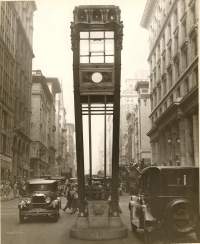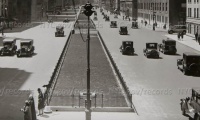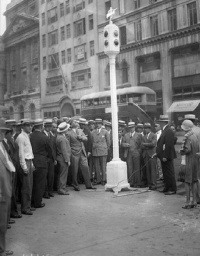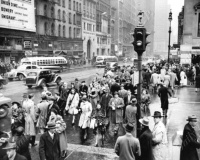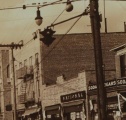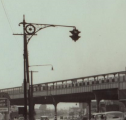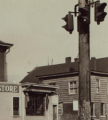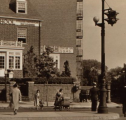New York City Intersections
This page is under construction.
Contents
Beginnings
Throughout New York City, various intersections (those that were typically major) were controlled mainly by either police officers or traffic control towers. With regards to traffic control towers, these were generally operated by police officers and red and green and red, amber, and green sets were in use. One kind of traffic control tower that is well known to date is the bronze tower, in which was designed by Joseph H. Freedlander and first unveiled by the 5th Av. Association in 1922. Approximately seven were installed on one segment of the major thoroughfare, and these were in use throughout the 1920s. The decorative design of the tower stood out the most, since Freedlander strongly believed in aesthetics. At the top, a police officer was stationed within the inside, and a set of red, amber, and green signal indications were in use.
While the bronze towers were able to provide adequate traffic control, there were some disadvantages. One to point out is the placement of the tower. The ideal spot at an intersection for this tower was the middle, and this eventually proved to be an obstacle for motorists that wanted to make left and right turns at intersections. Another disadvantage to take into consideration is the use of the amber indication. Though it indicates to motorists to slow down and come to a full stop, many motorists were rather confused by the indication and either tried to speed up to clear the intersection or stopped too early, in which either situation sometimes resulted in a bad accident. A solution to alleviate these common issues was necessary.
The first traffic signals
By the mid 1920s, New York City's police department introduced the first automatically-controlled traffic signals. These first appeared in the boroughs of Brooklyn and Manhattan, and they would soon spread to the rest of the other boroughs in the following decade. The new traffic signals, in which were manufactured by the Ruleta company, showed red and green signal indications to motorists, and this became a permanent standard for New York City traffic signals. Ultimately, the amber signal indication was abandoned. The police department's new system of traffic signals were synchronized, in which were intended for an ideal flow of traffic, and various precincts throughout the city had control centers for police officers to manually adjust signal timing (if necessary).
The earliest traffic signals in New York City were commonly attached to unusually tall pedestals, and solely one was in use at a major intersection. In later years, most, if not all, were either modified or removed from service. Because the traffic signals showed red and green signal indications to motorists, the original form of caution was what is commonly know as a "dark-out period." Both signal indications appeared unlit in between 1 to 3 seconds before the red signal indication then appeared lit. A red clearance then typically followed prior to when the other direction changed from red to green.
As traffic signals began to appear at more locations throughout the city, the ultimate removal of traffic control towers took place at the of end of the 1920s. This includes the seven bronze towers of 5th Avenue in Manhattan. Regarding these in particular, none were saved and preserved when the removal process took place at this time. Even so, an original model of Joseph H. Freedlander's traffic control tower is in the hands of a private collector today, while a replica of this is on display at the Museum of the city of New York. This is true for his original designs of the bronze tower as well.
Bronze signal
In 1929, the 5th Avenue Association planned to install a new set of traffic signals for one segment of 5th Avenue. As a result, Joseph H. Freedlander was asked to design a traffic signal, and the bronze signal was born. Manufactured by General Electric, the traffic signal was decorative, and a total of four sides were in use for red and green signal indications. Though most signal indications lacked actual cutaway visors, some were attached to these. One noticeable feature of the traffic signal was the statuette of the Roman god Mercury, in which was made of gilded bronze. On July 22nd of 1929, Joseph H. Freedlander's traffic signal was first unveiled and tested at the corner of 5th Avenue and W. 57th Street. In total, 104 would be installed by 1931. From Washington Square Park to W. 59th Street at Central Park.
Golden age
The 1930s to 1950s is considered as the golden age of two-section traffic signals in New York City, since they first became widespread in the 1930s and eventually the norm by the 1940s. Traffic signals manufactured by the Ruleta company were heavily in use throughout the boroughs; however, at least two other kinds were in existence in this time period. They are traffic signals from General Electric and Horni (presumably).
A classic set-up at an intersection in New York City had two traffic signals at two corners. One was located diagonally across from the other. A fixed four-way traffic signal was typically in use, and each one was generally mounted to its own pedestal, in which was manufactured by Union Metal. Regarding the pedestal, the base was stamped with a statement that read "PROPERTY OF THE CITY OF NEW YORK" and a year of manufacture.
Aside from the classic signalized intersection, others throughout the boroughs used various configurations, due to some factors, such as location and complexity. Though many traffic signals were attached to pedestals, others were suspended as well. For this in particular, typically only one suspended head controlled an entire intersection, while it could be observed that both pedestal-mounted and suspended traffic were both in use at an intersection.
